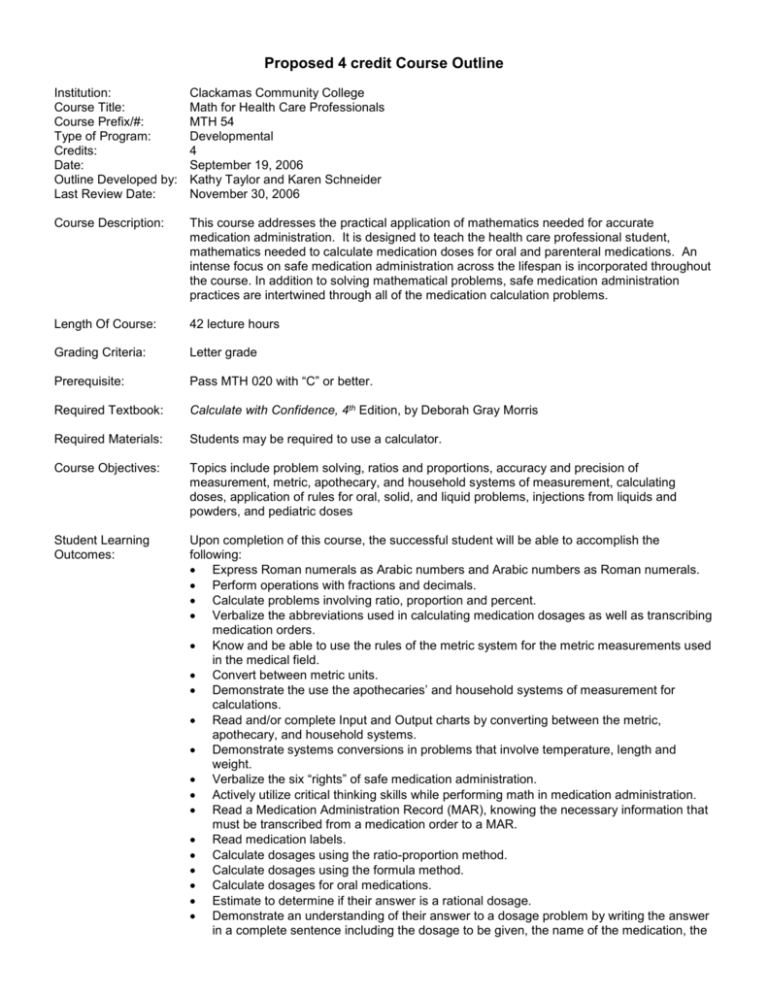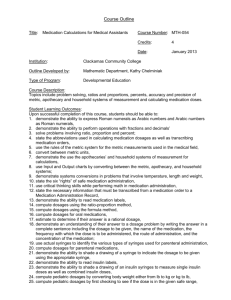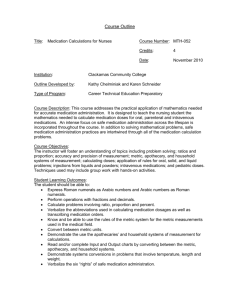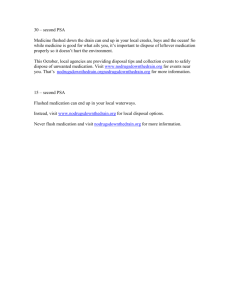MTH 054 Outline - Clackamas Community College
advertisement

Proposed 4 credit Course Outline Institution: Course Title: Course Prefix/#: Type of Program: Credits: Date: Outline Developed by: Last Review Date: Clackamas Community College Math for Health Care Professionals MTH 54 Developmental 4 September 19, 2006 Kathy Taylor and Karen Schneider November 30, 2006 Course Description: This course addresses the practical application of mathematics needed for accurate medication administration. It is designed to teach the health care professional student, mathematics needed to calculate medication doses for oral and parenteral medications. An intense focus on safe medication administration across the lifespan is incorporated throughout the course. In addition to solving mathematical problems, safe medication administration practices are intertwined through all of the medication calculation problems. Length Of Course: 42 lecture hours Grading Criteria: Letter grade Prerequisite: Pass MTH 020 with “C” or better. Required Textbook: Calculate with Confidence, 4th Edition, by Deborah Gray Morris Required Materials: Students may be required to use a calculator. Course Objectives: Topics include problem solving, ratios and proportions, accuracy and precision of measurement, metric, apothecary, and household systems of measurement, calculating doses, application of rules for oral, solid, and liquid problems, injections from liquids and powders, and pediatric doses Student Learning Outcomes: Upon completion of this course, the successful student will be able to accomplish the following: Express Roman numerals as Arabic numbers and Arabic numbers as Roman numerals. Perform operations with fractions and decimals. Calculate problems involving ratio, proportion and percent. Verbalize the abbreviations used in calculating medication dosages as well as transcribing medication orders. Know and be able to use the rules of the metric system for the metric measurements used in the medical field. Convert between metric units. Demonstrate the use the apothecaries’ and household systems of measurement for calculations. Read and/or complete Input and Output charts by converting between the metric, apothecary, and household systems. Demonstrate systems conversions in problems that involve temperature, length and weight. Verbalize the six “rights” of safe medication administration. Actively utilize critical thinking skills while performing math in medication administration. Read a Medication Administration Record (MAR), knowing the necessary information that must be transcribed from a medication order to a MAR. Read medication labels. Calculate dosages using the ratio-proportion method. Calculate dosages using the formula method. Calculate dosages for oral medications. Estimate to determine if their answer is a rational dosage. Demonstrate an understanding of their answer to a dosage problem by writing the answer in a complete sentence including the dosage to be given, the name of the medication, the Major Topic Outline: frequency with which the dose is to be administered, the route of administration, and the concentration of the medication. Use actual syringes to identify the various types of syringes used for parenteral administration. Calculate dosages for parenteral medications. Shade a drawing of a syringe to indicate the dosage to be given using the appropriate syringe. Read insulin labels. Shade a drawing of an insulin syringes to measure single insulin doses as well as combined insulin doses. Calculate pediatric dosages by converting body weight either from lb to kg or kg to lb. Calculate pediatric dosages by first checking to see if the dose is in the given safe range. Calculate pediatric dosages based on mg per kg. Calculate pediatric dosages using body surface area (BSA) using the West nomogram or either of the metric or Arabic formula. Review of Arithmetic (Chapters 1 - 5) Roman Numerals, Fractions, Decimals, Ratio, Proportion, Percents Units and Measurements for the Calculation of Drug Dosages (Chapters 6 - 9) Metric and Household; Apothecary and Household; Apothecary and Metric Methods of Administration and Calculation (Chapters 10 – 15) Medication Administration, Understanding Medication Orders, Medication Administration Records, Reading Medication Labels, Calculating Doses Using Ratio-Proportion, Dose Calculation Using the Formula Method Oral and Parenteral Dose Forms, Insulin, and Pediatric Dose Calculations (Chapters 16 – 21) Calculation of Oral Medications, Calculation of Parenteral Medications, Calculations of Medications involving Powdered Drugs; Administering Insulin, Calculation of Pediatric Doses Heparin Calculations (Chapter 23) Heparin Calculation of Subcutaneous Dosages Suggested timeline: CLASS HOURS 4 5 18 2 13 42 TOPIC Review of Arithmetic Units and Measurements for the Calculation of Drug Dosages Calculation of Drug Dosages Drug Administration Considerations Reviews, Assessments, Final Exam









